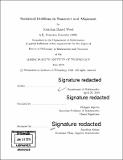Statistical problems in transport and alignment
Author(s)
Weed, Jonathan Daniel.
Download1117775024-MIT.pdf (9.139Mb)
Other Contributors
Massachusetts Institute of Technology. Department of Mathematics.
Advisor
Philippe Rigollet.
Terms of use
Metadata
Show full item recordAbstract
How should you analyze complicated data? Faced with scans of handwritten digits, noisy snapshots of large biomolecules, three-dimensional LIDAR data, or corrupted social networks, what practical techniques and theoretical guarantees does the statistician have at her disposal? This thesis develops new theory for statistical problems involving data with geometric structure of this kind. First, we study the Wasserstein distance, a metric on the space of probability measures on an arbitrary metric space. We prove sharp rates of convergence for empirical measures in Wasserstein distance on sufficiently regular compact metric spaces, improving on a line of work going back to Dudley (1969). We give the first nearly-optimal minimax lower bounds for the problem of estimating the Wasserstein distance between two measures, and we prove much better rates can be obtained under three different structural assumptions on the measures. These assumptions, inspired by practice and theory, reveal novel statistical features of the Wasserstein distance. Second, we consider data corrupted by group transformations. These problems are motivated by cryo-electron microscopy, an important technique in structural biology, the use of which requires reconstructing the structure of biological macromolecules on the basis of noisy, randomly rotated images. We prove the first minimax rates of estimation for a two-dimensional version of this problem. Along the way, we develop a general theory for problems of this kind, applicable to arbitrary compact groups acting on R[superscript d], and provide a novel analysis of the maximum-likelihood estimator for Gaussian mixtures with algebraic structure.
Description
Thesis: Ph. D. in Mathematics and Statistics, Massachusetts Institute of Technology, Department of Mathematics, 2019 Cataloged from PDF version of thesis. Includes bibliographical references (pages 169-181).
Date issued
2019Department
Massachusetts Institute of Technology. Department of MathematicsPublisher
Massachusetts Institute of Technology
Keywords
Mathematics.